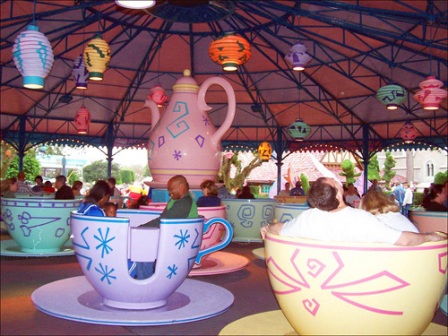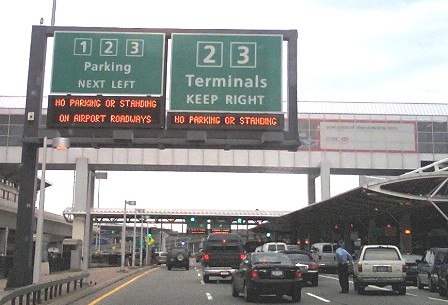On my coveted “Bane of Americana” list just behind my cell phone company's automated customer support option to “Press '3' To Stay On Hold” (not kidding!), is the so-called “Passenger Pick-Up System” at airport terminals. Instead of realizing a purported orderly and safe system, by forcing cars to circuit the entire loop road in an attempt to perfectly intercept with arriving passengers, airports are perpetuating a half-brained scheme reminiscent of Disney World's Mad Tea Party ride. It's Always Six O'Clock At Terminal Eight!
On my coveted "Bane of Americana" list just behind my cell phone company's automated customer support option to "Press '3' To Stay On Hold" (not kidding!), is the so-called "Passenger Pick-Up System" at airport terminals. Instead of realizing a purported orderly and safe system, by forcing cars to circuit the entire loop road in an attempt to perfectly intercept with arriving passengers, airports are perpetuating a half-brained scheme reminiscent of Disney World's Mad Tea Party ride.

It's Always Six O'Clock At Terminal Eight!
As I'm sure you know, the way this system works is that when you pull up to the "Arrivals" area you are not allowed to stop unless the passenger(s) you are picking up are physically standing on the sidewalk. If you have not magically timed your arrival to intercept with your party, the game is to creep, crawl, or hide somewhere along the strip either out of sight or at some proximity from the nearest traffic officer where you predict is beyond their desire range to walk and shoo you away. If you wind up in any kind of interaction with the officers, they will say you can not wait there and must move along. Ask "Where?", and they will tell you to drive around the entire airport (some officers are more Mad Tea Party purists by just shooing you to the next pick-up area at that terminal where the next officer will then also shoo you along as well, but at least they don't shout "Treacle"). And so hundreds of cars wind up circuiting airport roads, weaving between shuttle buses, rushing cabbies, drivers looking for other terminals, drivers on cell phones trying to intercept their arriving passengers, etc., in a senseless, uncoordinated, and wasteful loop. If there ever was a half-thunk plan, here it is in stark madness at almost every major airport I've visited.
To dispense with the security argument, I am completely in favor of keeping explosive-laden terrorists away from airport terminals, so the policy of "No Standing" unless physically picking up a passenger is absolutely spot-on. My contention is with the non-plan part of the system of shooing cars away and forcing them to loop around the airport, weaving around each other like teacups in the Mad Tea Party ride. The repetitive flow of cars along terminal frontage is itself a security concern. This involves a lot more work for the officers, per vehicle, since they likely have to shoo the same vehicle several times, particularly if passengers disembark slowly, immigration is backed-up, or luggage is slow to the belt, although these delays practically never, ever, ever happen, right?

Couldn't There Be Some Place to Park and Stand?
So what then is the alternative? In a world where cell phones are ubiquitous and security measures are typically designed to "minimize exposure", I propose an amended system where a layover area is provided far outboard of the terminals in a secure location (perhaps near long term parking) with wayfinding signage directing drivers to wait there until their passengers find their way to the Passenger Pick-Up Area. Arriving passengers can call their escorts when they get outside. Engines off, fewer vehicles circuiting airport loop roads, and a great place to generate additional revenue via snack, coffee and other vendors (think: interstate highway rest area). A large "Arrivals" board, similar to those provided inside terminals, can be made available, with additional "checkpoint confirmations" informative to awaiting escorts such as when the first passengers of each flight disembark, clear immigration, customs, and baggage carousels. The total capacity of such a facility during peak periods can easily be calculated, but is probably much less than 1,000 spaces, even for larger airports. Some airports maintain such layover areas for taxis (Boston's Logan comes to mind); why can't the same be provided for private cars?
Perhaps there is some immensely obvious reason such a system is not currently provided, but I suspect it is simply because, with security often being the one and only priority, no one has ever considered the secondary aspects of the current system. Hopefully some amendments will be made to future airport design to simplify and improve the accuracy of escorts intercepting passengers. But most important, it would allow me to remove "Airport mad tea party" from my "Bane of Americana" list.

Planetizen Federal Action Tracker
A weekly monitor of how Trump’s orders and actions are impacting planners and planning in America.

Chicago’s Ghost Rails
Just beneath the surface of the modern city lie the remnants of its expansive early 20th-century streetcar system.

Amtrak Cutting Jobs, Funding to High-Speed Rail
The agency plans to cut 10 percent of its workforce and has confirmed it will not fund new high-speed rail projects.

Ohio Forces Data Centers to Prepay for Power
Utilities are calling on states to hold data center operators responsible for new energy demands to prevent leaving consumers on the hook for their bills.

MARTA CEO Steps Down Amid Citizenship Concerns
MARTA’s board announced Thursday that its chief, who is from Canada, is resigning due to questions about his immigration status.

Silicon Valley ‘Bike Superhighway’ Awarded $14M State Grant
A Caltrans grant brings the 10-mile Central Bikeway project connecting Santa Clara and East San Jose closer to fruition.
Urban Design for Planners 1: Software Tools
This six-course series explores essential urban design concepts using open source software and equips planners with the tools they need to participate fully in the urban design process.
Planning for Universal Design
Learn the tools for implementing Universal Design in planning regulations.
Caltrans
City of Fort Worth
Mpact (founded as Rail~Volution)
City of Camden Redevelopment Agency
City of Astoria
City of Portland
City of Laramie






























